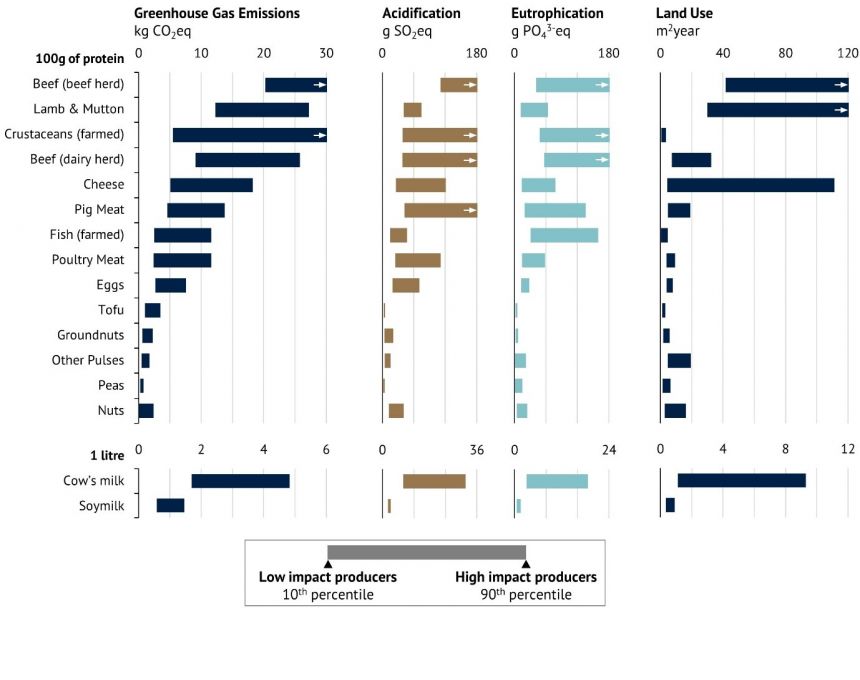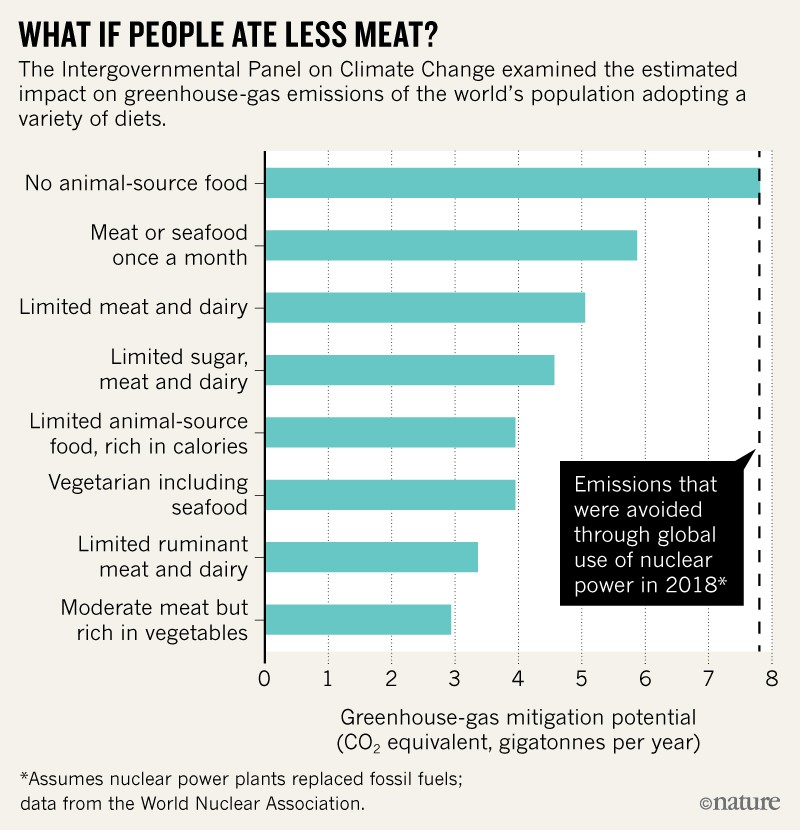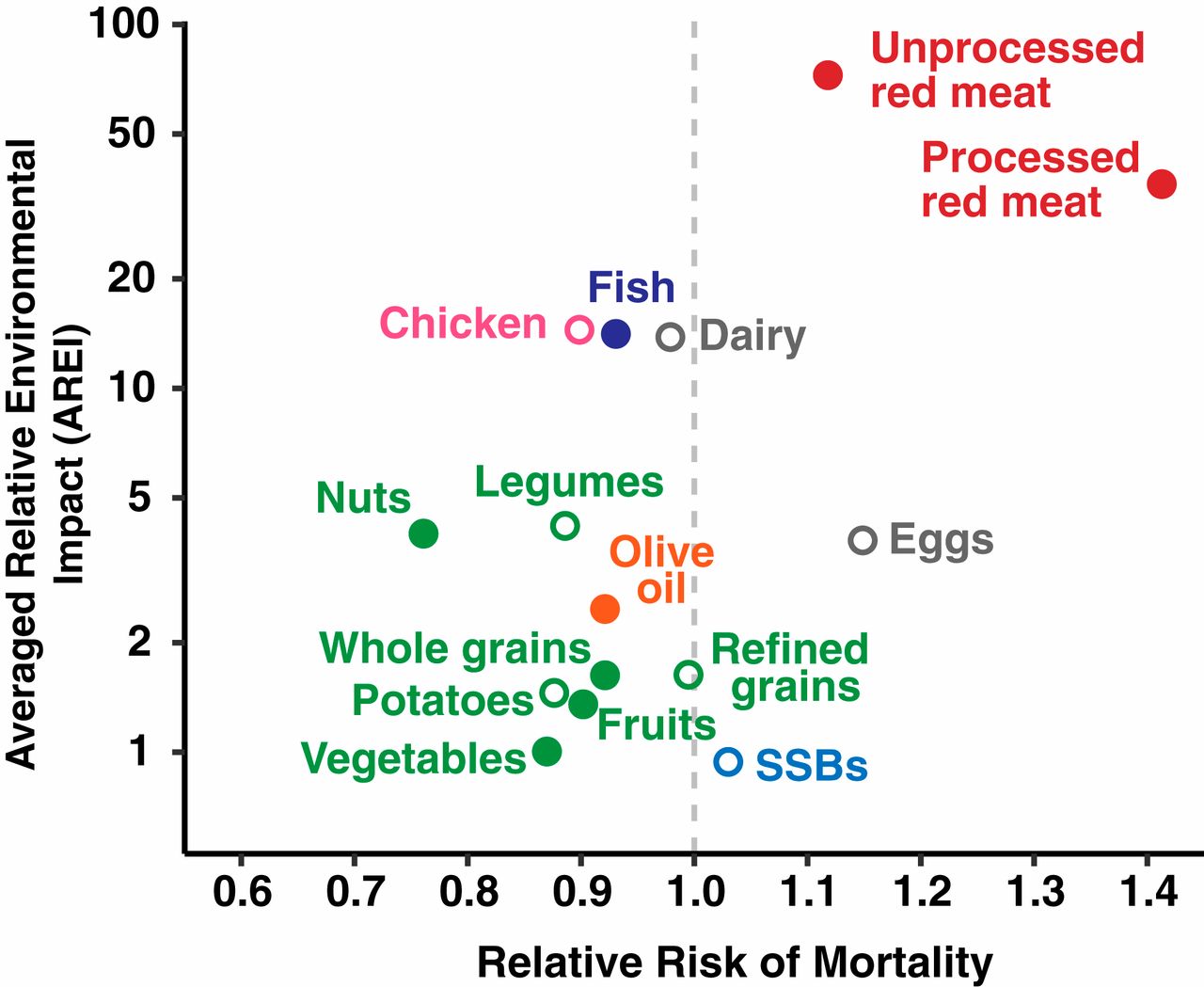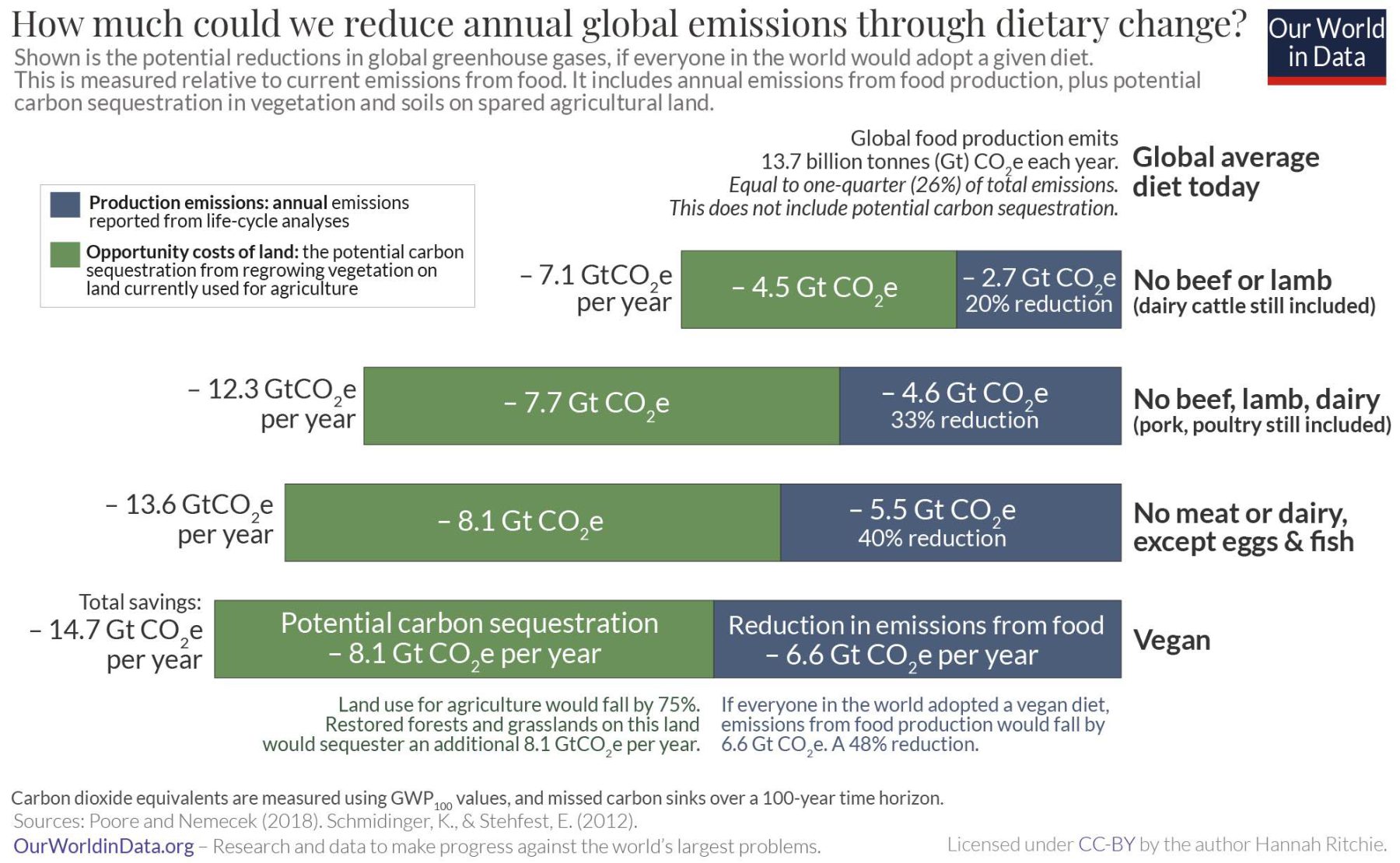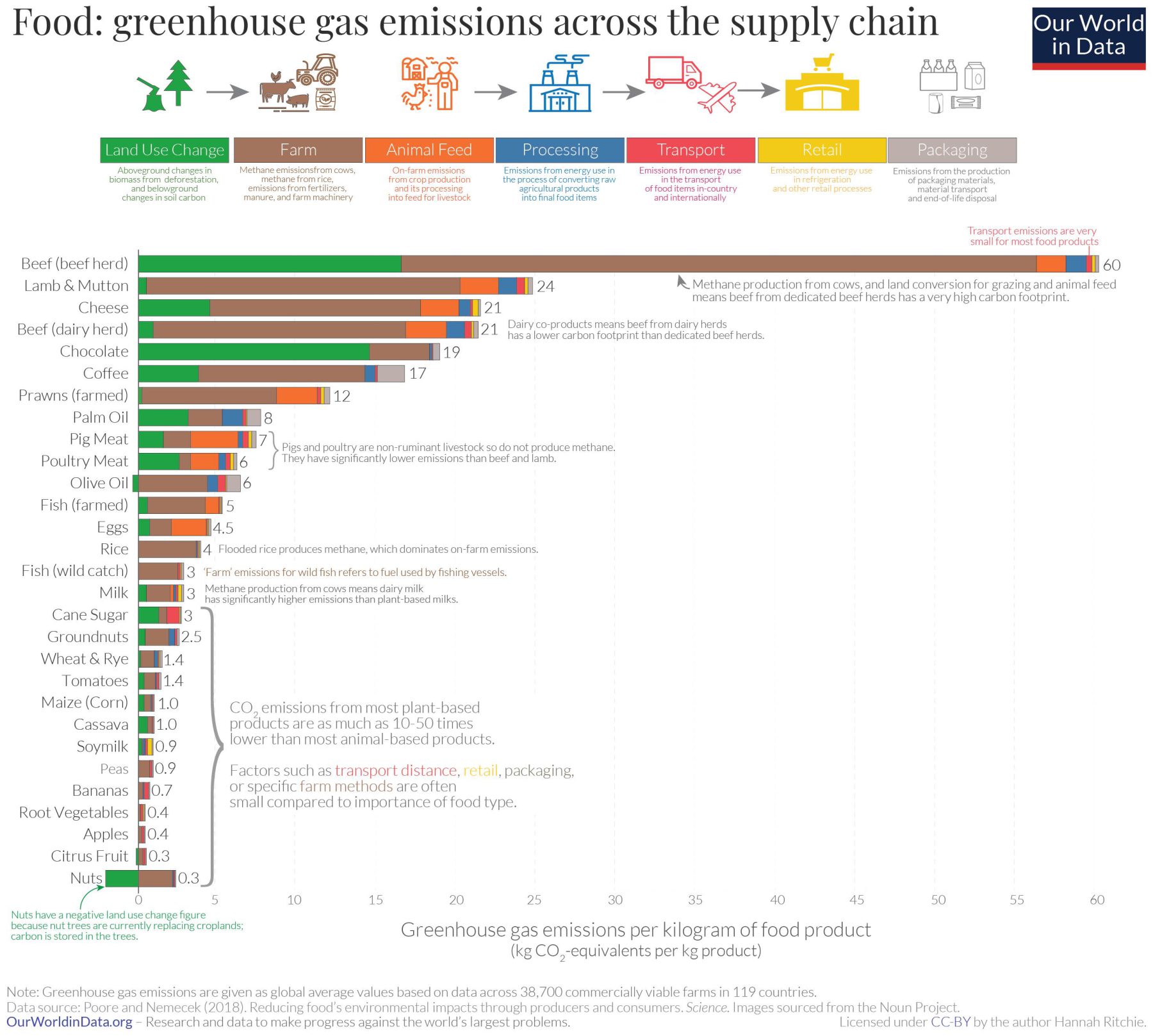We have known for decades that our dietary choices can have a powerfully negative impact on the planet, but in the past five years, the evidence has become overwhelming. With the climate crisis already upon us, global waterways polluted, whole ecosystems destroyed, and wild species dying out at a devastating rate, reducing our food impact has become of paramount importance.
Five Amazing Studies That Show Us The Way
There is now a significant body of evidence that points us to the solution to these serious environmental crises. Take a look at these five studies by highly reputable and respected researchers.
1. Lund University, 2017.
This comprehensive study analysed 39 peer-reviewed articles, carbon calculators and government sources to pinpoint the most impactful ways that individuals can reduce their own climate impact. It found there were four key actions that people could take but that these were rarely mentioned in government recommendations and education initiatives, which tended to favor small incremental changes such as recycling or using cloth bags instead of plastic. The four actions are: living car-free, reducing flights, having fewer children and eating a plant-based diet. They found, for example, that switching from plastic to canvas bags is less than 1 per cent as effective for the climate as a year without consuming meat.
2. University of Oxford and Agroscope, 2018.
Researchers from Oxford University in the UK and the Swiss agricultural research unit created the most comprehensive database yet on the environmental impacts of nearly 40,000 farms, and 1,600 processors, packaging types, and retailers. Together, this allowed them to assess environmental effects for 40 major foods. While there was significant variability among each product, the impact of animal-derived foods versus plant foods was absolutely clear.
3. Intergovernmental Panel on Climate Change, 2019.
More than 100 experts, around half of whom come from developing countries, worked to compile a comprehensive report that examined climate change, land degradation, sustainable land management and food security. The headlines generated urged governments and policymakers to encourage people to eat less meat, but take a look at which diet it found to be best for reducing our climate impact …
4. University of Minnesota and University of Oxford University, 2019.
Researchers set out to identify a range of foods that are both good for health and good for the planet. They found that whole grain cereals, fruits, vegetables, legumes, nuts and some vegetable oils high in unsaturated fats, such as olive oil, were associated with improved health and also had the lowest environmental impacts. Foods with the largest negative environmental impacts – red meat, and all processed meat – were consistently associated with the largest increases in disease risk. Dairy, fish and poultry meat also had significant environmental impacts, but just look at which foods are marked in green!
5. Our World In Data, 2021.
This study looked at the ‘carbon opportunities’ available to us should we change our diets. By examining data on emissions and the carbon costs of individual food items, Dr Hannah Ritchie was able to quantify the benefits to the climate of the whole world adopting different kinds of diets. She found that by cutting out red meat, we could save 7.1 gigatons of CO2 a year, which is a very good start. Cutting out dairy takes that figure higher, cutting out chicken and turkey takes it higher still, and guess what diet is the best for our climate? If everyone was vegan, we could save 14.7 gigatons of CO2 a year. Remember this figure. We’ll be returning to it later.
These studies are credible, vitally important and very influential, and the number of people choosing to eat plant-based foods to better protect the planet is increasing rapidly. No wonder then that the well-funded and well-connected meat industry has started fighting back.
Smoke and Mirrors: What the Tobacco Industry Taught the Meat Lobby
In the 1950s, as evidence relating to the dangers of smoking mounted, tobacco companies launched a concerted and strategic PR offensive to undermine and distort the science. They could not stop the independent research that was linking their products with cancer, and lung and cardiac diseases. However, they could work to undermine public health recommendations by eroding confidence in those studies and confusing people with their own “research”, while simultaneously working to manage the media’s coverage of these issues. This was the first time in US history that an industry had hijacked science with an aggressive and sophisticated marketing campaign driven entirely by self-interest. It would not be the last. As Allan M. Brandt of Harvard University concluded in his study Inventing Conflicts of Interest: A History of Tobacco Industry Tactics:
“A wide range of other industries have carefully studied the tobacco industry strategy. As a result, they have come to better understand the fundamentals of influence within the sciences and the value of uncertainty and skepticism in deflecting regulation, defending against litigation, and maintaining credibility despite the marketing of products that are known to be harmful to public health. Also, they have come to understand that the invention of scientific controversy undermines notions of the common good by emphasizing individual assessment, responsibility, and judgment.”
One industry that has certainly learned these lessons is the meat lobby.
Fighting Fires On Two Fronts: Health and Environment
With powerful evidence that all processed meat causes cancer and that red meat is also a probable cause, and that eating animal products is also connected to, type 2 diabetes and heart disease, the meat lobby has been working hard to counter these facts.
Every five years, the United States federal government issues dietary guidelines to help Americans choose healthy foods. Still, despite being one of the richest countries in the world, America is ranked as only the 35th healthiest country, and at number 46 in terms of life expectancy. What happened? Says Dory McMillan, Master’s student at Clark University: “The US government first started providing nutritional advice to the public with the goal of reducing healthcare costs, however as time went on, it seems as though this goal was overhauled by the USDA’s desire to promote and maintain the agricultural industry and their interests.”
The meat industry is not alone in working to engineer our food choices, despite the cost to our health. In 2011, Dr Michael Greger disclosed that: “The USDA Dietary Guidelines Committee has been made up of individuals funded by McDonald’s, Coca Cola, the Sugar Association, the American Meat Institute, candy bar companies, and the egg and dairy board.”
If you are interested in finding out more about how our food choices are manipulated by the animal farming/meat industry, we recommend reading Meatonomics.
Now, with evidence mounting that meat is also a key driver of deforestation, habitat loss and greenhouse gas emissions, the industry is fighting fires on two fronts – health and environmental – and all the while, the world is fighting literal fires caused by climate change, driven by this industry.
Sleight of Hand: Animal Agriculture’s Policy of Misdirection
With the weight of evidence against them, the animal farming industry has had to search for ways to convince global citizens to keep on buying and eating its products. Let’s take three examples: animal agriculture’s contribution to antibiotic-resistant pathogens, the role of soy in deforestation, and methane emissions from ruminant animals.
Antibiotic resistance is incredibly serious, and it is driven by the overuse of these precious drugs. Already, drug-resistant bacteria sicken 2.8 million Americans each year, and kill around 35,000 people, according to the Centers for Disease Control and Prevention. As of 2016, around 69 percent of all medically important antibiotics in the US were sold to be fed to farmed animals and the reason they use so much is because of the appalling conditions that farmed animals are forced to live in. The industry tends to deal with this issue either by withholding key evidence or by loudly celebrating areas where there is reduction in usage, however small. It certainly does not acknowledge that the industry cannot survive without antibiotics because those sickening factory farm conditions make that impossible. But does the industry want to end their usage? Antibiotics are also growth promoters and that comes in very handy when the weight of animals equals profit. Research shows that the very best way to reduce antibiotic usage in farmed animals is to cut back on eating meat, but the industry’s silence on this is deafening.
As for the soy issue – the fact that soy is connected to deforestation, including in the Amazon – the industry deals with this by shouting loudly that tofu is the problem, not meat. This is classic deflection, blaming vegetarians and vegans when the evidence could not be clearer: most soy is used to feed farmed animals. In fact, chickens, pigs and other farmed animals are fed an incredible 30 times more soy than is consumed in tofu.
The same kinds of tactics are used in relation to the production of methane by ruminant animals. The industry talks up reductions (“we’re making efficiencies”, “we’re selectively breeding cows so they fart less”, “cow numbers are declining”, etc.) and a whole lot more misdirection: “look over there … fossil fuels are much worse”.
This sleight of hand, this deliberate misdirection, has worked to an extent. But as the charge sheet against animal agriculture grows ever longer, and the powerful evidence against them mounts, so too does the industry’s need to come up with arguments that seem scientifically credible, that make them look like they are on the right side of history, and will cast just enough doubt to stop people changing their behavior. After all, it worked for the tobacco firms.
What is Regenerative Farming?
Robert Rodale coined the phrase “regenerative organic” to describe a system of farming that goes beyond sustainability. After all, sustainability suggests we work at the very limit of exploitation, whereas regeneration seeks to undo the damage already done. Regenerative agriculture prioritizes soil health for biodiversity but also, more recently, is seen as a way to limit climate change. Plants remove carbon from the atmosphere and store it in the soil, which is why the widespread deforestation and other habitat destruction for grazing farmed animals is so very damaging to our planet.
Seven Principles of Regenerative Farming
Robert Rodale described “seven tendencies” of regenerative farming:
1. Pluralism, or the diversity in plant species
2. Protection, which indicates the need for cover crops to end soil erosion and increase microbial populations within the soil
3. Purity refers to avoiding pesticides and fertilizers
4. Permanence indicates the planting of more perennials and other plants with vigorous roots
5. Peace calls for harmony with nature, working with it rather than fighting against it
6. Potential describes the nutrients that are already available and can make their way up to the surface of the soil and be used by plants
7. Progress refers to the work to keep improving soil quality
These ideas are not new. These are age-old indigenous farming practices where we work with nature, reap what we need, and take our responsibilities to the natural world seriously – a far cry from the reckless and short-sighted approach of the modern, post-colonial, stack-’em-high-sell-’em-cheap world. Today, as the damage caused by modern agriculture is becoming widely known, regenerative farming has once again come to prominence. If we genuinely put these principles into practice, there is no doubt that the health of our planet would improve.
As Philip Lymbery, CEO of Compassion In World Farming says: “The future of farming must be nature-friendly and regenerative, and our diets must become more plant-based, healthy and sustainable. Without ending factory farming, we are in danger of having no future at all.” (The Guardian, 2021)
Regenerative Agriculture: Four Key Principles
With everyone talking about regenerative farming, The Climate Reality Project describes what it means in more detail, and lists four of its key principles:
- Since ploughing and tillage erode soil and release carbon dioxide into the air, reducing or ending these practices creates healthier, more resilient environments for plants to thrive, and prevents carbon from being released.
- Increasing plant diversity helps create rich, varied, and nutrient-dense soils that naturally lead to more productive yields.
- Adopting rotation techniques and using cover crops boosts soil health and protects it from erosion.
- Minimizing chemical use can help protect soil and prevent some of the many water pollution incidents that are related to farming.
Hijacked!
These sound good, don’t they? And they are. Regeneration – putting right the damage inflicted on the natural world – could not be more important, but it is being hijacked by the animal farming industry.
Hijacking is another common lobbyists’ tactic. Here are three examples:
When the campaign to end battery cages for hens started to gain traction in Europe, the animal farming lobby swung into gear. Sensing which way the wind was blowing, it supported an end to battery cages, only to propose bigger cages. And it won. Battery cages are banned in Europe, but hens there are still caged.
When people really started to listen to environmentalists and understand that the UK sport shooting lobby was responsible for the deaths of hundreds of thousands, perhaps millions, of wild animals every year, the shooting lobby got behind initiatives to “save songbirds”. It commissioned its own “research” and discovered – surprise! – that the songbirds’ predators were the exact same species it was killing for its own ends. It then used these “facts” – which were disputed by other credible researchers – to support its own killing agenda.
And when new restrictions were coming into play to protect people from the effects of smoking, the tobacco lobby hijacked the 2014 EU public consultation using “numerous third parties to lobby on their behalf”.
Likewise, the farming industry has hijacked the regenerative agriculture debate, listing its own four key principles:
- Minimize soil disturbance
- Keep the soil covered
- Maximize plant or crop diversity
- Integrate ‘livestock’
Do The Environmental Arguments For “Livestock” Stack Up?
There are two main arguments put forward for grazing cows and sheep on cover or cash crops on arable land. The first is that they produce organic matter (manure) that acts as a natural fertilizer and helps boost soil fertility. The second is that grazing animals encourage new plant growth, and this stimulates the plants to pump more carbon into the soil.
Now, we know that manure has been used for millennia and that even organic farmers rely on it. There is no doubt it supports fertile soil provided it is applied in the correct amount at the right time of year. But there is a downside, too, of course, in that there is far too much of it, and that it runs off the soil and into the waterways where it causes eutrophication, algal blooms, mass deaths of aquatic creatures in rivers, and ocean dead zones. Clearly, too much is a problem, but what would happen if we tried to farm without manure altogether? Could we do it? The answer is yes. There are a growing number of farmers around the world who work in accordance with veganic principles, using “green manure” or fertilizer made entirely from plants. They work with nature and without using the antibiotic-contaminated slurry byproducts of factory farms. For more information about farmers working this way, see:
We don’t need manure to farm productively.
So, we come to the second argument for farming cows and sheep, which is that they can stimulate plant growth which helps sequester carbon in the soil. First, is this true? And if so, how big an impact can it have?
The World Resources Institute has been looking into these claims. Its thorough report concluded that “the practical potential was at best modest” due to several challenges, including that studies on grazing land had found that the effects of grazing on soil carbon are complex, site-specific and hard to predict. They claim that agriculture needs to close an 11-gigaton greenhouse gas gap to hold global warming below that all-important 2-degree rise above pre-industrial levels.
Eleven gigatons. Remember that fifth study we cited above? It showed that 12.3 gigatons of carbon could be sequestered if we grew vegetation on the land currently used to graze or feed sheep and cows. So, far from being part of the solution, farming cows and sheep is very much a big part of the problem. And this is the least we have to do. An 11-gigaton saving should keep us below a 2-degree rise, but the lower the rise, the better for all of us, and that study found that we could save 14.7 gigatons if we all became vegan.
Down The Rabbit Hole
All the while, our attention is being focused on this one narrow argument about whether there is a place for cows and sheep in regenerative agriculture, the slash-and-burn deforestation continues to wreak havoc on our planet, and methane emissions keep on rising.
And all the while, the multi-billion dollar meat industry continues to rake in the profits, and to set aside part of those profits to lobby governments. The largest meat company in the world, JBS, is linked to Amazonian deforestation and battles its way through a scandal after scandal – from workers’ rights, to water pollution incidents to “siphon[ing] off government funds intended for struggling American producers”.
In the last 13 years, JBS has spent more than $7.7 million on lobbying. Incredibly, this makes it only the fourth largest political spender in the meat processing industry. No wonder so little has been done at the political level to control this reckless and damaging industry.
Confirmation Bias
It’s obvious why the meat industry uses all the duplicitous tactics of the tobacco lobby, but why do normal citizens argue so vehemently for “livestock” farming as part of a regenerative agriculture policy? If you’ve seen Cowspiracy, you’ll know the extent to which many environmental organizations go to hide the damaging impact of animal agriculture. (If you haven’t seen it yet, we highly recommend it. Check it out on Netflix.) It may be that those organizations are fearful of losing funding from meat-eating donors; it may also be that the individuals who form policy at those NGOs also like eating meat.
And so, when faced with an argument or a study that backs up what we want to believe, people naturally leap on it. It’s why “environmentalists” can be seen chowing down on a burger, made with meat from a factory-farmed cow, whose methane contributed to global warming and who was fed on soy from deforested lands.
We also see this play out in those who argue that locally produced meat is better for the planet than flying fresh vegetables around the world, when the evidence shows very clearly that this is not true. The distance a product travels is actually a very small part of its overall emissions.
This research led George Monbiot, environmental researcher and journalist to explain that: “Even if you shipped a banana six times around the world, the impact would be lower than local beef and lamb.”
It is a human psychological tendency to cling to any research – flawed, biased, misrepresented or misunderstood as it may be – that allows us to continue doing what we like to do unchallenged. It’s so common that psychologists have a name for it: Confirmation bias.
It is this same tendency that prompts people to state that they buy “organic”, “high welfare” or “grass-fed’ meat as if a) that covers all ethical and environmental issues and b) it is all they ever buy, and they never purchase or consume meat in a restaurant, at a friend’s house, from a take-away sandwich shop, when on holiday, or in a pre-packaged meal from the store because they cannot be sure of its provenance.
Why do we trick ourselves like this? We want to feel like we’re the good guy; we don’t like to be proved wrong; and we don’t want to change our own behavior.
Staring Us In The Face
We urgently need to tackle the massive impact that animal agriculture has on our planet. Study after reputable, credible study has come to the same conclusion: we need to eat a lot less – or preferably no – meat. Such a change would also positively impact both individual and public health, and the health of our planet’s wild places and inhabitants. In fact, almost every crisis facing us today – climate, biodiversity, health, pandemic risk, and antibiotic resistance – can be tackled with this one simple solution.
Of course, the industry will try to derail this. It has learned its lessons well. But we must not allow ourselves to be sidetracked by industry-proposed “solutions” that are no more than a deflection tactic. The scale of the crisis is immense, but the way forward is clear.

